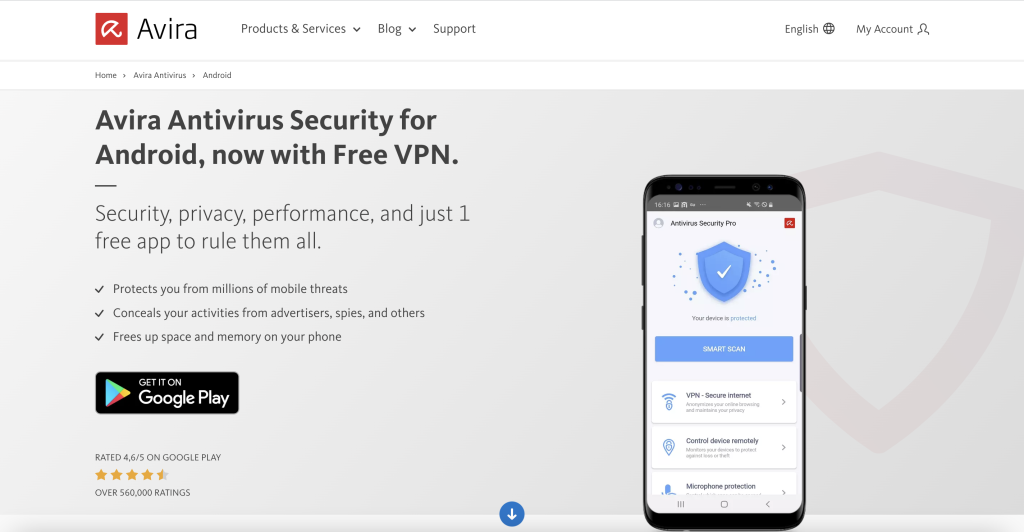When you buy an Android smartphone or tablet, it typically always comes with a huge number of pre-installed apps that you may not always want. These apps are called bloatware, because they do just that — bloat your device unnecessarily.
Although you can easily remove some of these pre-installed apps, you can only disable others on your Android device. Experts say it’s best to hide these unwanted apps that can’t be deleted.
Read on to learn all about how to hide unwanted apps on Android – but also how to hide apps with sensitive data. In addition, find out how Avira Antivirus Security for Android can help increase privacy on your device.
Why is it important to hide unwanted apps?
Pre-installed, unwanted apps — even those that you can’t uninstall — can eat up your precious storage space, sap your battery life, and waste your data plan unnecessarily because they collect information and display notifications on your phone, which can get really annoying.
Save your sanity by disabling and hiding certain apps to stop receiving unwanted notifications and make it much more difficult for apps to gather data in the process. This also reduces the strain on the battery and your device’s memory.
By the way, you can do a lot to keep your Android smartphone or tablet running at peak performance by regularly optimizing its memory and RAM. As such, it’s a good idea to get a security solution for Android that also offers optimization tools like Avira Antivirus Security for Android.
In doing so, you equip your device with a security solution that allows you to check your device for a possible malware infestation. This solution can also do a whole bunch more because, in addition to various tools to protect your online privacy, it also includes an optimizer that helps you tune up your Android smartphone or tablet’s memory and performance.

There may be another reason to hide apps and files, such as if you lend your smartphone or tablet to your kids or others from time to time. In doing so, you can minimize the risk of that person or your offspring from viewing sensitive, personal files or launching apps, such as dating apps, and seeing what you’re up to.
Speaking of offspring: To learn more about how to improve your children’s protection when online, check out our blogpost on this important topic.
Here’s how to hide unwanted apps on your Android device
There are several ways to hide unwanted or sensitive apps, such as:
- Removing unwanted apps right from the home screen
- Hiding apps via the Settings app
- Hiding individual apps and files with the Secure Folder app
- Managing the visibility of files and apps with the help of launcher apps
Remove unwanted apps from the home screen
The quickest and easiest way to hide unwanted apps on many of the latest Android devices is to:
- First, unlock your Android smartphone or tablet.
- Then tap and hold your finger on the icon of the app you want to hide until a small context menu appears.
- Now select Remove to hide the unwanted app from your home screen.

Hide apps via the home screen settings
If you want to hide unwanted apps via your Android device’s settings, proceed as follows:
- First tap the Settings app, swipe up a little, then select Home screen.
- Under Home screen settings, tap Hide apps.

- You’ll then see an alphabetical list of the apps installed on your Android device. Hide them simply by selecting them.

Use Secure Folder to hide apps
Secure Folder is an app that’s built into all newer Samsung Galaxy devices by default. However, if you want to use the Secure Folder app to back up data and hide apps, you’ll need to set up this folder first — plus you’ll need a Samsung account that you’re logged into.
In the following guide, as in all instructions in this blogpost, we use a Samsung Galaxy S21 FE 5G, but the procedure is identical starting from the Galaxy S9.
- To start, open your phone’s Settings app.
- Swipe up a little and tap the Security and privacy menu item (on older versions of Android this menu item is called Device security).

- Select the Secure Folder option.

- When the setup wizard starts, you’ll be shown some tips on how to use the secure or secret folder.
- Once the set-up process completes, which can take up to two minutes, you’ll be prompted to choose how to secure your folder, such as with a PIN, iris scan, your fingerprint, or an unlock pattern.
- This completes the setup of your secure folder and you can move files or apps into it, hiding them from prying eyes.
You’re free to choose which home screen page you want the Secure Folder app icon to appear on. The home screen page we use for demonstration purposes isn’t exactly the right place, so put the app icon on another page.
Since you’ve already protected your secure folder and potentially moved it to a different location, it should be difficult for anyone else to access the apps and files stored there.
When you open your newly created secure folder, you can customize it, such as by changing the icon and color or giving this app a different name. We believe that’s a good move, because it shouldn’t be immediately apparent to anyone using your device that you’re using a secure folder.
In addition to individual files, you can include any app containing potentially sensitive data in this folder, so that it’s then also hidden. However, we can’t show you any additional screenshots for this, since this is ultimately the secure folder.
Hide apps with Android launcher apps
Instead of using the Secure Folder app, you can also use a launcher app on your Android device. You’ll find a bunch of them on the Google Play store, including Nova Launcher Top, App Hideout, App Hider, or Apex Launcher — although some freeware versions of these apps don’t come with the app hiding feature.
In our following guide we’re using Apex Launcher on our Samsung Galaxy S21 FE 5G:
- First enter Apex Launcher in the search box of Google Play, install this app, and then tap Open.
- Tap Skip when prompted about Apex Launcher Pro so you don’t accidentally end up on a paid subscription and confirm this again in the next step when you’re offered the free trial period.
- You’ll then be prompted to choose which launcher app you want to use. Select Apex Launcher.
- The home screen of your Android device will now look different because Apex Launcher controls it. The app will have also added several more app icons (Apex Menu, Apex Pro, Themes, and Apex Settings).
- To hide apps, first tap the Apex Settings app followed by Hidden Apps and then Choose Apps to Hide.
- You’ll see an alphabetical list of all your apps, and you can now select the ones you want to hide. Once you’ve made your selection, tap HIDE (number) APP(S).
- The selected apps will now no longer be displayed in the app drawer or home screen. But remember to also remove the Apex Launcher app from the home screen. If you want to make the app visible again, repeat the previous steps but select the Unhide option under Hidden apps.
Set up a guest account or secret mode
We’ve already mentioned that it might be a good idea to hide apps and sensitive files such as if you let your child play with your smartphone or tablet or if other people have access to your device.
In this case, it makes sense to set up a guest account or secret mode on your Android device.
- To do this, first open the Settings app on your smartphone or tablet.
- Swipe up and tap Accounts and backup, then on Manage accounts.
- Now tap the plus icon and follow the additional instructions. If you’ve been able to add another profile, you can easily switch between users by tapping the user icon in the notification menu and selecting the relevant user.
However, if you can only add email and other accounts, your device probably doesn’t have this option. Thankfully, though, you can still set up guest access with the SwitchMe app from the Google Play store.
Disable apps to hide them
If you want to disable(unwanted) apps to hide them, it’s easy to do — but it’s unsuitable for hiding apps with sensitive data, such as your online banking app.
- First tap the Settings app, swipe up a little and then select Apps.
- Find the app you want to hide from the list and tap its icon.
- Now select Disable at the bottom of the screen so the app is no longer displayed on your Android device.

Finding hidden apps on Android
You can use the Settings app to find apps that you disabled to hide them. Tapping Apps will show you all the apps installed on your Android device, including those that aren’t on the home screen because they’ve been disabled.
Tips for managing apps on Android
You can also manage the apps on your Android smartphone or tablet without any third-party apps. But to ensure we cover all the bases, we’ll delve into Android app managers at this point.
These are management tools that allow you to manage the apps installed on your Android smartphone or tablet. Among other things, app managers can show you details about an app as well as allow you to browse installed apps or generate reports on frequently used and unused apps.
The best tools to manage apps on Android
There are a whole host of tools out there to manage apps on Android devices, and they generally work in a fairly similar way. Three of these management tools caught our eye:
- App Manager for Android lists all the apps installed on your smartphone and external storage, giving you an easy way to search for your desired app. Additionally, you can move apps to external storage to free up your device’s memory. Other features, such as the ability to remove apps, clear caches, or share apps with others, are designed to make it easier for you to manage the apps on your Android device.
- AppMgr (known as App2SD) is another app manager for Android that allows you to easily and conveniently manage the apps on your Android smartphone or tablet. You can move apps to internal or external storage, or hide or freeze system apps from the app list to speed up your smartphone or tablet. In addition, this app manager allows you to share apps with friends as well as remove and clear app caches to make room for more files.
- Fone – Phone Transfer also allows you to manage all your phone’s apps directly from your computer, which can come in handy. With this app, you can easily download, install, remove, share, and export Android apps or move them to another location to free up storage space.
How can I protect my privacy on my device?
We’ve already mentioned that some cutting-edge security solutions can improve your online privacy. Avira Antivirus Security for Android is one such latest-gen security solution. It includes several tools that can help improve your privacy both online and on your device, including:
- App Lock to lock apps and control access to them — a feature that’s quick and easy to set up.
- Breach Monitor, which alerts you if your email addresses have been involved in a data breach.
- A VPN (virtual private network) to help protect your online privacy when surfing using public Wi-Fi hotspots thanks to its sophisticated encryption technologies.
- Permissions Manager, which allows you to find out which apps can access your private data and potentially be threatening your online privacy.














